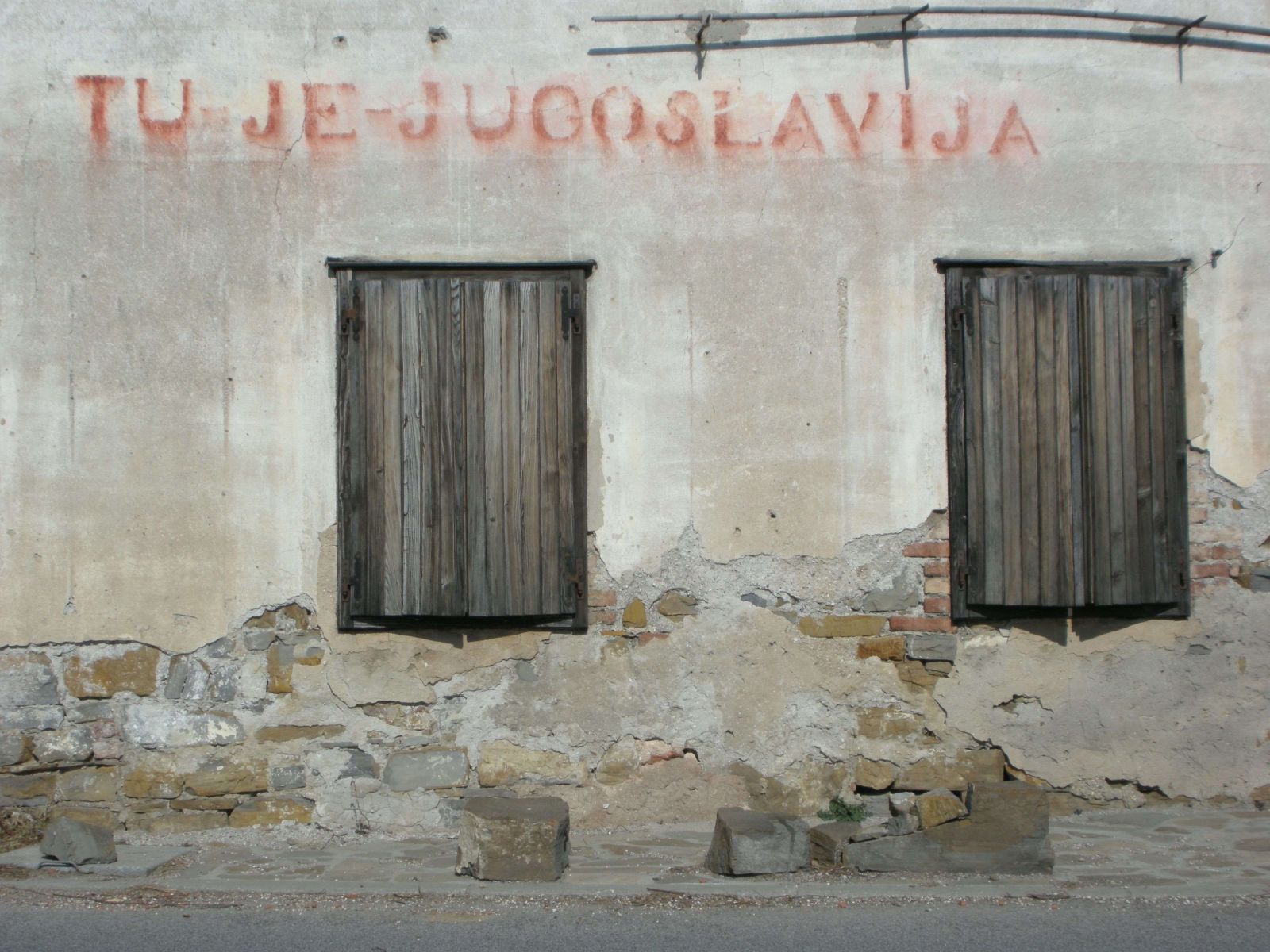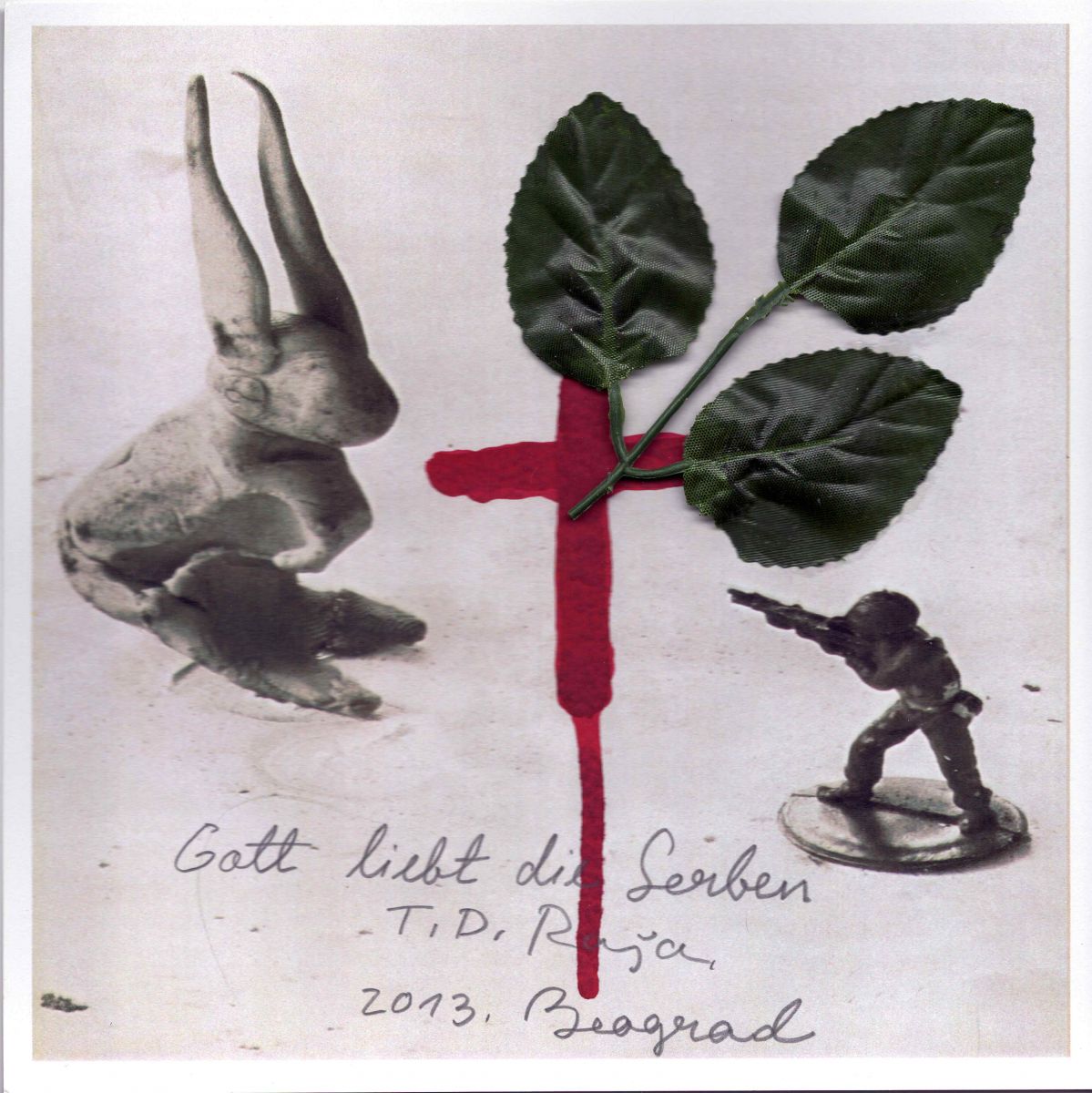voyage in europe. the taste of salt
curator: the cultural centre of belgrade

an exhibition by
Uroš Đurić
Siniša Ilić
Vladimir Nikolić
Darinka Pop-Mitić
Dragoljub Raša Todosijević
opening
Saturday the 21st of March, 2015, 6 pm
a co-production Kulturni centar Beograda (Cultural Centre of Belgrade) and Trieste Contemporanea
with the support of the Ministry of Culture and Information of the Republic of Serbia
curators: Zorana Đaković Minniti and Mia David
the opening of the exhibition will be held on March 21st , at 6 pm
During the evening will take place:
the poetic performance The ballad of the revolver that dreams the love, by Marko Tomaš
the presentation of the storybook by Dragoljub Raša Todosijević, edited for the exhibition
and a meeting with the artists
finissage on April 23rd, at 6 pm
for the conclusive evening of the exhibition: Focus Serbia, a special edition of VIDEOSPRITZ international meetings with the Video Art
The exhibition VOYAGE TO EUROPE. THE TASTE OF SALT opens on the 21st of March (Studio Tommaseo, via del Monte 2/1, at 8 pm).
It is a site specific exhibition proposed to be held in Trieste by the Kulturni Centar Beograda (Cultural Centre of Belgrade) as part of a longer project due to touch upon different European cities, realized with the collaboration of Trieste Contemporanea and with the support of the Ministry of Culture and Information of the Republic of Serbia.
Among the themes treated in the exhibited works, the tragics of the war in Yugoslavia, the clash of political ideologies, of differents ethnicities and religions are represented and interpreted by the artists. Using differents media – from the traditional lithography to the video installation – the works are dense, cruel and poetic, often permeated by a surreal spirit, funny and biting. Stories, small portraits and images of border people narrate the desperation, the poverty but also the love and the hopes of the Balkanian people.
The artists from Belgrade Uroš Đurić, Siniša Ilić, Vladimir Nikolić, Darinka Pop-Mitić and Dragoljub Raša Todosijević present in Trieste a series of unreleased works selected by the curators Zorana Đaković Minniti and Mia David.
During the opening event the presentation of Al gatto turco will occur, an unreleased book of stories, translated in italian for the first time, by the writer and artist Dragoljub Raša Todosijević from Belgrade. The author, one of the protagonists of the avant-garde movement of Belgrade during the seventies, a provocative body performer and a writer of crucial critical texts, at the opening of the exhibition will attend the opening and will talk with the curators and the public about his unreleased collection of stories.
Of great interest is the finissage on the 23rd of April as well. On that date Focus Serbia, a special appointment of VIDEOSPRITZ-international meetings of Video Art, dedicated to the most interesting and original new video productions from Serbia, will conclude the exhibition.

UROŠ ĐURIĆ, Vade Retro, Satana, Video installation, 2015
Two friends, fifty-year-olds, a Muslim from Sarajevo and a Serb from Belgrade, get together after 31 years on Sabotin Mountain above Gorica where they first met in March 1984 as nineteen-year-old soldiers, members of the Yugoslav People’s Army border service, and faithfully fully bonded forever, sharing a nonconformist view of the world. In the drastically changed historical circumstances during which in past decades they lived through the gradually deteriorating socialist order, the creation of ethnically-based states out of the former federal units of the joint state, civil war, the siege of Sarajevo, the UN embargo, exile, mobilization, ethnic cleansing, NATO bombing, marauding transition, neoliberal precariousness and compradors, they are once again in Ljubljana, starting their two-day trip toward the former border of a country that no longer exists, stopping at the places that were taboos once and which no longer have a meaning for the newly – established, pseudo – universalistic, unquestionable social reality, which, like all the previous ones, aspires at the establishment of a permanent and definitive order. [March 2015]

SINIŠA ILIĆ, Eight Landscapes of Pollution and Slavery, Lithography, 2015
I cannot be sure, but when I try to think about the kinds of pictures I saw on the walls and in the books I leafed through, I would say that they were prints. There were a lot of them in that house, the walls had framed, impenetrable forests and nudes, and the books most often showed liberation, fighting or war. Some of the books of prints, that it seems to me were called portfolios, had a wide variety of pictures, abstractions, far-off places, animals, I can’t remember whether they were by foreign or local artists.

VLADIMIR NIKOLIĆ, The First Murder, Video installation, 2008, 2ʹ25ʹʹ
The murder of Yugoslav King Aleksandar I Karađorđević on 9 October 1934, in Marseille, was recorded by a camera. The footage of this murder was distributed in the West at the time by Universal Newsreels and presented as the most unbelievable pictures ever taken. In the context of the paradigm of 20th century media society that whatever has not been recorded by a camera never even took place, the murder in Marseille can be understood as a proto-murder, since it was the first murder to take place in front of the media’s eye. The First Murder, a two-channel video installation, is a reconstruction of the footage of that event, but not of the event itself. New footage was filmed from the same positions where cameras had been placed on the day of the assassination, and a detailed map with camera locations on the street was drawn up because of the fact that the part of La Canebière where the murder took place has remained almost the same to this day. The new footage has no murder, all we see is the daily, routine life of the street – unimportant footage that in the presence of the historical footage indicates the disappearance of the event, i.e. the fact that in a media society pictures become more important than what they present.
.jpg)

DARINKA POP-MITIĆ, Life Cycle of a Star, 2015
Star life cycles are more or less known to cosmologists and astronomers today. Stars are born in large explosions, most live their historical lives as the center of a planetary system and then, decaying in unbelievable nuclear explosions, they slowly burn up and become increasingly unstable until they implode, causing a magnificent event that fills the night sky – the supernova – and finally become black holes. Nevertheless, some theoretical astrophysicists believe that a black hole is not only the remains of a star that has disappeared, but also a passage that can lead us to another world.
The work Life Cycle of a Star follows changes in the method and form of visual representations of the red star, the international banner of Communist movements, in the second Yugoslavia, with special reference to the League of Communists and its symbols during the period from liberation to the country’s implosion at the extraordinary 14th Congress of the League of Communists of Yugoslavia.

RAŠA TODOSIJEVIĆ, A brief and embellish version of my miserable life in Belgrade
I was born on September 2, 1945, in Belgrade, on Narodnog Fronta Street; before the Second World War the street was called Kraljice Natalije Street. First we – my honorable parents and I – lived on Rumunska Street, up in Dedinje (later called Užička Street). Then, for some reason or other, we moved to 17 Šajkaška Street. That’s down by the Dunav train station. When the city authorities inexplicably tore down that beautiful building in the French style, we moved to 115 Cvijićeva Street near the Novo Groblje Cemetery. Some ten or so years later, we moved to the suburbs, out in the sticks, to 21 Jablanička Street. Much later I finally got an apartment of my own, a tiny space of freedom in the neighborhood of Senjak, more specifically on Prahovska Street that used to be called Američko Sokače. When Marinela’s parents left this world, I settled down in the center of town on General Ždanova Street, which was given back its old prewar name of Resavaka Street several years ago.
First my half-deaf maternal aunt Stojanka tried with might and main to get me to learn the upholsterer’s trade and become an upholsterer like her brother, my uncle Pedi. Then I tried to be an army pilot in Mostar. Since I wasn’t very good at this either and I didn’t like the boring cadet crowd, I went back to Belgrade. I took a two-year drawing and sculpting course at 122a Šumatovačka Street. Finally, in 1964, one year after the earthquake in Skopje, I enrolled at the Academy of Fine Arts in Belgrade. My teachers at the Academy had embarrassingly little talent and even less education; a lethal mixture of mediocrity, bootlickers and conceited phantoms. I had no other choice but to travel around the world and educate myself as best as I could, so that using my meager forces I succeeded in shaking off the invisible yoke of wide-ranging provincialism. I was given an atelier exactly thirty years later at the so-called Staro Sajmište that was a German concentration camp during the Second World War. Sometimes as I listen to quiet music in the atelier, it seems to me that the sorrowful souls of the slain inmates come to visit and politely say hello. [Belgrade, 2009]